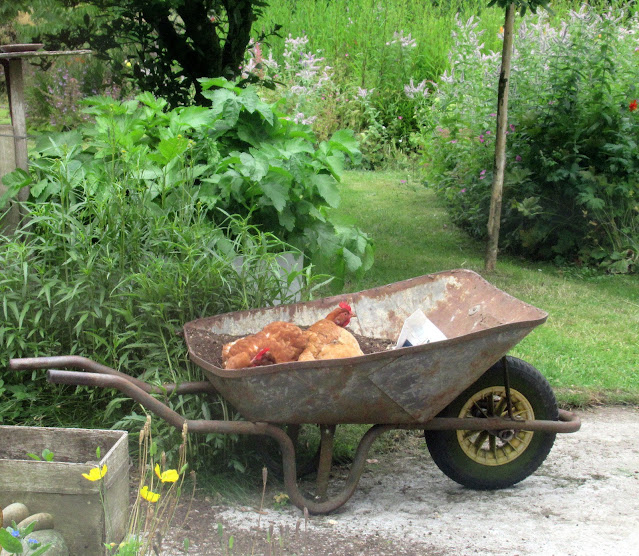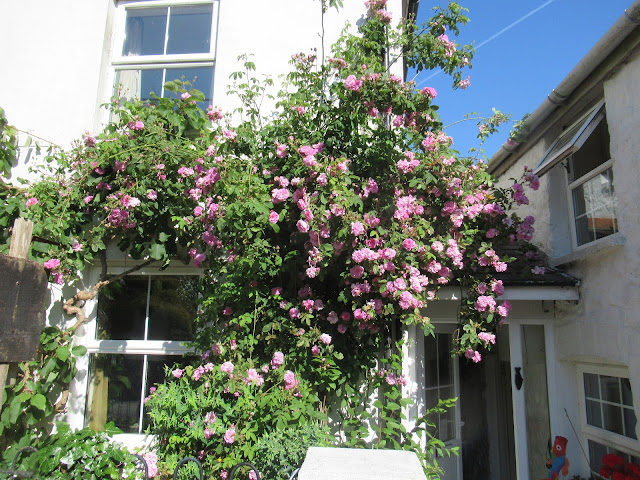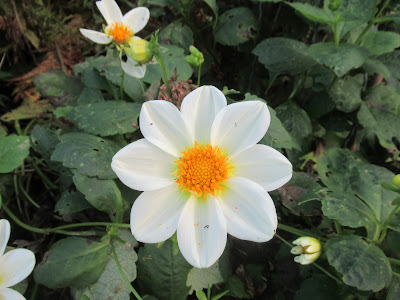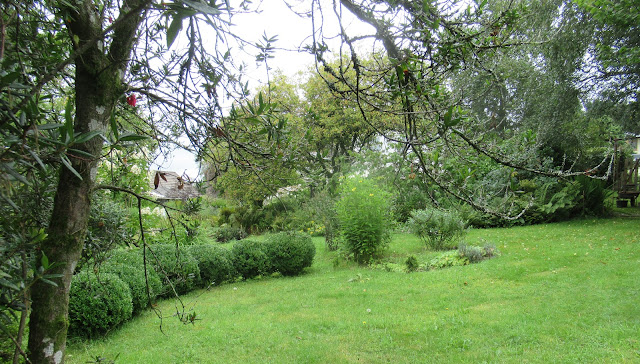Part 2
Continuing from the previous blog describing the development and changes to our garden from when we came her in 1969 to the present day. A garden is a dynamic organism and when in the same hands, it reflects the changes within the family it belongs to.
Just a taster from the 1970s when everything was growing anywhere.
The Orchard
At the very bottom of the garden is a square about 30x30 yards, which, thanks to a number of sawn-off apple tree stumps and one which was surviving and re-sprouting, we grandly called The Orchard.
An early order of several varieties of fruit trees was made and they have withstood the years with varying degrees of success. The apples, Bramley, Blenheim Orange and Ellison's Orange, do pretty well most years, with some feasts to famines. The Newton Wonder is showing signs of die-back and the original apple which re-grew from the stump is a local variety known as Pig Snout which is usually a good cropper, early-ripening but not a good keeper.
Outside the orchard in what was Kim's garden when she was a child, we have a local Tamar Valley variety, a graft by a friend, which is called King Byard. It crops very well on the whole, producing very big apples that are good for baking and with a good flavour.
Back in the orchard and part of the original order, were a crab apple John Downie, a Victoria Plum and a Damson, none of which thrived so were grubbed out. The two pears, a Conference and a William bon Chretien have mixed fortunes. We think pears are a difficult fruit as they either fall before they're ready, or have to be picked all at once and then they tend to ripen all at once too, so you can't keep up with eating them at their prime. The William in particular is very tricky. If we get a crop, the fruit tends to split while still unripe on the tree. I don't know what causes this, but the result is that in fifty years we've scarcely ever had anything worth eating from this tree. Only sentiment saves its life I think.
The daffodils which have always grown in the orchard are a very simple variety, not a great deal bigger or taller than the wild ones. Not as glamorous as the modern cultivars but it stands well in bad weather and the heads aren't so heavy and nodding as some. They are still in rows, reflecting some time probably dating to at least the 1950s when they were grown commercially. I knew the people who at this post-war time grew daffs for picking for the London market in the field below our orchard and there are still the relics of a few Pheasant-eye narcissi growing there. They are amazingly persistent.
The daffs are followed by bluebells. These were originally the generous Spanish species, blue and sometimes white. These cultivated ones are much maligned these days because they hybridise with our less vigorous natives and it's feared they will in time 'contaminate' our native bluebell woods.
The orchard is unmanaged until late August and into September when Tony cuts it with a scythe, section by section and then follows up with two or three mowings before the autumn has really set in.
A few other trees have sneaked in : a Gingko (for its novelty value), a Bird Cherry, a Balsam Poplar for its heavenly smell when the spring leaves are unfurling, an Alder and several Buddleias of various colours for the butterflies.
Our Family of Other Animals.
Over the years we have lived with a variety of two-legged and four-legged friends. Bridget our much-loved Alsatian has already sat in the limelight in the previous blog so she's had her mention.
Something nasty has happened to this 1983 slide.
Rather scruffy rescue hens from a battery house. After their terrible confined life they soon recover from their agorophobia and turn into true scratching hens and moult into good plumage.
Their companions here are a couple of Gleanies, notorious for their strident rattling calls. They were the first victims of Reynard who over the years has had his vigilance rewarded on all too many occasions.
Building the stable next to the orchard. Autumn 1978
Am I supposed to be here?
Oh well, I'll just cut the grass while I'm here.
Oh yes, this is Kim's horse Taurus AKA Pooh, by the way. 1979
Meet Gozzle & Pozzle 1986. G. the gander is on the left and P. the goose is on the right. We reared them from chicks and the enduring mistake was to let them imprint on us. Much loved, very spoilt, they had the run of the garden. The trouble was Gozzle thought he was King and he would endure no man in his territory. When Tony appeared, he had to talk to Gozzle in a high squeaky voice to avoid attack.
While we were in Australia for six months in 1989 G & P went to live on Bardsey. They were settled by Nant Pond and disgracefully, Gozzle terrorized anyone who went near. He resumed his lovey-dovey nature as soon as he came home. Mistaking me for his wife I was amused but slightly uncomfortable by his spring display behaviour, putting twigs and bits of plucked grass suggestively at my feet in nest-building mode. I wouldn't have wanted to be ravished by him unless maybe he turned into a handsome prince!
Sadly once again, Reynard had the last word.
PS....
Proud parents. The family's first outing, 1987
Chat through the fence. We have had a mix of ducks at different times.
The bantams. We ended up with two families. One with their cockerel lived in the orchard and the other with their cockerel lived higher up the garden but they all went to bed together.
They went to a friend while we were in Oz and guess what? Reynard had them too!
To get right up to date, after years going without poultry because of the fox problem, we decided during Covid to have some hens again and here are a couple of our three luxuriating in a dust bath. They are spoilt, cunningly reptilian, very companionable, love gardening and so far lay lots of eggs.
Plant crazes.
As well as the children's devotion to their cactus collections when they were young, Tony became keen on Bamboos. This has been a mixed blessing. They have mostly come from bits of root from naturalized clumps in woodland. They hadn't been dumped for no reason! Without exception they have been very invasive.
The first and now making a dense clump known of course as the Bamboozalem, keeps us in canes, makes a lovely children's den, roost for flocks of finches, and one year took part in the world-wide bamboo flowering event in 1983.
The rather squiffy flowers.
Despite claims that bamboos die after flowering (and if so why aren't they extinct?) although severely weakened, they recovered within a few years.
Most highly prized is a very tall stout, yellow-stemmed sort which makes huge canes in a single year. We have one as our stair bannister and another as a railing for the top pond bridge.
I became interested in Snowdrops some years ago, having seen all the different ones in the garden at Buckland Monachorum in Devon. I only have under a dozen of the hundreds available (at a price!)
We inherited rows of what I call Cornish Double in the orchard and which I have scattered throughout the garden subsequently. It is widely naturalized at least in the lanes round here.
Sam Arnott a very handsome snowdrop.
On the left......A hybrid which seems to have appeared spontaneously in the garden in the past three years. It's very vigorous and I think more handsome than the rather muddled lumpy 'Cornish Double' on the right.
Ferns. Continuing from my botanical interest in wild ferns, and capitalizing on the readiness of wild ones to appear in the garden anyway, Lady Fern is really quite a weed and if not winkled out when very small, needs a pickaxe to get out the sturdy rootstock.
One of my favourites, the delicate black-stemmed Oak Fern. It disappears in winter so I'm always pleased to see its inconspicuous croziers just nosing through again in the spring. We first saw it growing wild in wet woodland where we were camping in southern Sweden.
Roses aren't on the whole, happy here in our mild wet winters and clean air. Of many we have tried, few flourish. We were given a cutting in a bucket some years ago, of Isphahan, an old Persian variety. It grows by our front door and its a show-stopper in a good year.
Wedding Day makes a wonderful though brief show over the arch between the veggie beds and the 'Cricket Pitch'
The single, glowing pink Apothecary's Rose, Rosa gallica, suckers freely. This one comes from the now derelict garden in North Wales of RS Thomas the Welsh poet of whom we have affectionate memories.
Sadly we have a very full graveyard of rose labels of loved ones that haven't stood the test of time.
Dahlias. I began my relationship with dahlias many years ago when I bought a bucketful of tubers for 65p from Stoke Garden Club plant stall. I still have this one, a semi-double, semi pom-pom, very robust cream colour. I have added and lost others of different types but my latest enthusiasm is to grow the single ones from seed. They germinate readily and with luck flower the same year, but can be saved overwinter and grown on. Bees love them.
I name these myself for convenience. This one's worth keeping I think and I call it Virginal.
This one I call Will Scarlet. Not sure about it. Either cheerful or garish! But it's fun seeing how they'll turn out.
Rockery.I think a rockery is tricky to get right. It's so easy to produce a 'dog's grave'. I love alpine plants but again I'm ambivalent. Most favourite is to see them growing naturally, in the mountains where they belong. I also love the immaculate displays of specimens at an Alpine Show. As I can't spend much time in the mountains and and haven't the single-minded dedication needed to tend an Alpine house, I compromise.
We rebuilt our first rockery because it was invaded by weeds.
1999.
Tony : "I'm running out of stone!"
In our damp climate the stones quickly get mossy. Years ago I was given cowslip seeds by a friend in Hertfordshire and although we are very acid, the cowslips are still with us in all their promiscuousness. We now get false oxlips, red cowslips, sort -of Polyanthus etc etc.
Something plays havoc every year with these plants as they come into their best and I start to think 'Ah! I've got away with it this year!' when overnight, along comes the phantom tweaker and OFF WITH THEIR HEADS! I grow my most precious ones in the fruit cage where they escape the beheaders, so it isn't mice.
Tulips. I'm going full circle as I didn't care for tulips when I was younger. Why ever not? I'm really hooked on them now. I was inspired by the most wonderful show of all sorts being grown by a lady in Helland and I now put in an order to a Dutch grower every summer. It's two lots of pleasure for the price of one; first looking at his so-tempting website and then seeing them flower in their big pots the following spring.
The guru, Christopher Lloyd recommended that you treat Tulips as annuals and don't try and struggle to get them to repeat the next year. I confess I do, by saving the biggest bulbs of those saved and dried in the summer but I put them in the garden and if they flower again, it's a bonus. But mostly they do tend to divide into smaller, non-flowering bulbs.
What a difficult task it is, to choose which ones to order. I am torn between the flamboyant, like last year's Black Parrot and the red and white vulgarity of Estelle Rijnveld, and the more traditional and dignified Darwin type with their pure tulip shape.
You can imagine, I am looking forward to this year's lot, already showing good growth in their pots outside the greenhouse.
Simplifying.
From 1989 we made many trips overseas for some years. On a couple of occasions we were away for six months at a time, and never less than a month, so what had been quite a plantsman's garden steadily lost the smaller choice plants and gradually was taken over by thuggish vigorous and invasive plants. I don't mind the rush of Welsh Poppies in the spring but by the autumn I begin to get oppressed by the ever-expanding clumps of rather weedy Michaelmas Daisies.
Every return from a trip meant an orgy of sorting out the garden. As I got older and was losing the battle with Ground Elder, the most difficult to manage beds were given up. I took out such plants as I wanted to rescue and then handed over to Tony and the mower. Its surprising how a couple of years' mowing will turn a ground elder-infested flower bed into more lawn, and it was far easier for Tony to mow a bit more than for me to struggle with a difficult bed.
However, you can't have it all ways and I wouldn't have missed the travel for worlds.
The main design of the garden remained intact but down the lefthand-side border, instead of one continuous bed, it is now fragmented. The righthand-side border has more plots of grass scalloped into its far side. But that's all, and it does save a lot of difficult work.
I call this 'The Very Hungry Caterpillar' . This space used to be the middle section of the left-hand border. The Box Balls started life as tiny cuttings. I'm tempted to try and trim them into Nessie or a dragon.....
Wildlife
Going hand in hand with the simplifying of the garden, the combination of less(??) work, advancing years, and the opportunities for just sitting and looking afforded by Covid have enabled us to relax and enjoy our own wildlife under our noses. We have always fed the birds but more sitting has allowed us to be able to enjoy nesting, rearing of young, wash-and-brush-up sessions in the pond.
Cock Siskin feeding on sunflower seeds. We hear singing males here in the summer so they are no longer just winter visitors.
The Sparrowhaawk had chased a Blackbird into the fruit cage when the gate had been left open by mistake.
Fieldfares occasionally visit to eat discarded windfall apples if we have a hard spell. (spot the other one on the right.)
Rabbits and deer and squirrels are less welcome and we are always on tenterhooks about fox visits. The occasional hedgehog is welcome but not the mice and voles which raid the broad beans and peas as they germinate, and move my crocus corms around. Wildlife and gardeners aren't always good bedfellows.
Squirrel scoffing sunflower seeds.
Any hung feeder tests their agility and ingenuity and they usually win in the end.
The greatest diversity is the insect life. By night we set the moth trap in the orchard or in the main garden from time to time.
Robinson light trap. Over the years we have trapped (identified and released) over 400 species, mainly resident but occasional migrants from the continent.
We are growing more flowers with open centres with stamens exposed to favour nectar and pollen-feeding insects, and also making sure we have flowers in the later part of the summer to extend the feeding season.
Comma butterfly on Michaelmas Daisy
Painted Lady, Small Tortoiseshell and a Comma feeding on nectar-rich Sedum.
One of our biggest thrills has been to see in 2014 and again in 2019 a White-letter Hairstreak Butterfly feeding on a wild mint I was foolish enough to bring into the garden from Germany many years ago (see Mistakes later on.) This is a very rare butterfly in Cornwall and the caterpillar feeds on Wych Elm. Our big Wych Elm grows just behind this flower bed so the butterfly didn't have to come far.
The old Eucalyptus stump is slowly rotting and it now produces great clumps of Sulphur Tuft fungi
and the larvae of this long-horned beetle The Tanner, feed for some years within the decaying trunk before the adult emerges. This one actually came into the moth trap one night.
We have newts, frogs and toads using the pond and for many years we feel specially privileged to have a very large Grass Snake. We have watched her hunt frogs in the pond, found her cast skin draped over twigs and have seen both clusters of hatched eggs in the compost and various sizes of young, from pencil-sized to teenagers, over the years.
Tony has put down some squares of carpet in warm places and the grandchildren watch with bated breath as they are lifted to reveal, sometimes, a resting grass snake or slow worm.
A clump of Grass Snake eggs in the compost. They have already hatched.
Slow Worm basking.
Mistakes over the years have been many and varied but I like to think most of them were made in the early years. Most of them unfortunately are still with us.
Inexperience led me to take the most bog-standard cultivars available rather than enquire further to get more choice specimens. This especially applies to the Wych Hazel (Hammamaelis mollis) where a much more attractive pale yellow flower is available, rather than my strongly orange one. And the Mahonia japonica has a much more attractive form than mine.
You won't believe it, but I was once misguided enough to put in a Winter Heliotrope in the days when I'd put ANY plant in. It took a good ten years to get rid of it!
I've already mentioned that when putting down the parking place, we should have put a membrane down before laying the chippings. It would I'm sure, at least lessen the chore of weeding it every year (and it really needs doing more often than that.)
Other inappropriate additions have been inferior forms of Michaelmas Daisies. The superior ones seem to be short-lived but the weedy ones spread like crazy.
And the arch-spreader is what I call the German Mint (Mentha longifolia) a very handsome silvery-leafed plant with long terminal flower spikes of pale mauve. It has a pungent small when you crush the leaves; no good as a culinary mint. But the insects adore it.
The downside is it's underground running roots. Every winter I yank out at least a barrow-full from the bed it inhabits; by the summer, there it is again, undaunted.
So not exactly a mistake but perhaps I should have put it in a strong prison cell.
On the upside, to end on a positive note, I think the original layout has proved robust enough to still work even after the adjustments of the 'Simplification'. The main central lawn takes the eye down through the main part of the garden, and the side paths take you on little voyages of discovery, much enjoyed by children and I find also by visiting adults.
Half of me really likes to see individual plants growing in a bed with clean soil round them to show them to full advantage, but my other dominant half tends to overplant so that by mid summer everything is growing into its neighbour (and hopefully holding each other up!). Some people like this exuberance, but others find it claustrophobic. I do notice this crowded look is difficult to do justice to in a photo whereas a garden with a strong structure and good hard lines, such as the Lutyens/Jekyll garden at Hestercombe in Somerset photographs very well.
We have been fortunate enough to have sufficient space for all sorts of leisure play by the children and then their children, while still having room for me to indulge whatever whims I might come up with.
I have scarcely done any justice to so many more of my favourite plants. If I were to write this again another time I'm sure the plants mentioned would mostly be a different lot.






























































































